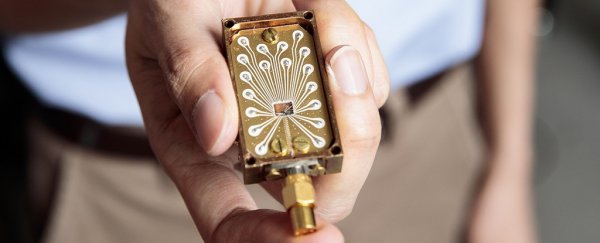Newly created artificial atoms on a silicon chip could become the new basis for quantum computing.
Engineers in Australia have found a way to make these artificial atoms more stable, which in turn could produce more consistent quantum bits, or qubits - the basic units of information in a quantum system.
The research builds on previous work by the team, wherein they produced the very first qubits on a silicon chip, which could process information with over 99 percent accuracy. Now, they have found a way to minimise the error rate caused by imperfections in the silicon.
"What really excites us about our latest research is that artificial atoms with a higher number of electrons turn out to be much more robust qubits than previously thought possible, meaning they can be reliably used for calculations in quantum computers," said quantum engineer Andrew Dzurak of the University of New South Wales (UNSW) in Australia.
"This is significant because qubits based on just one electron can be very unreliable."
In a real atom, electrons whizz in three dimensions around a nucleus. These three-dimensional orbits are called electron shells, and elements can have different numbers of electrons.
Artificial atoms - also known as quantum dots - are nanoscale semiconducting crystals with a space that can trap electrons, and confine their movement in three dimensions, holding them in place with electric fields.
The team created their atoms using a metal surface gate electrode to apply voltage to the silicon, attracting spare electrons from the silicon into the quantum dot.
"In a real atom, you have a positive charge in the middle, being the nucleus, and then the negatively charged electrons are held around it in three-dimensional orbits," explained solid state physicist Andre Saraiva of UNSW.
"In our case, rather than the positive nucleus, the positive charge comes from the gate electrode which is separated from the silicon by an insulating barrier of silicon oxide, and then the electrons are suspended underneath it, each orbiting around the centre of the quantum dot. But rather than forming a sphere, they are arranged flat, in a disc."
Hydrogen, lithium and sodium are elements that can have just one electron in their electron shell. This is the model used for quantum computing. When the team creates artificial atoms equivalent to hydrogen, lithium and sodium, they can use that single electron as a qubit, the quantum version of a binary bit.
However, unlike binary bits, which process information in one of two states (1 or 0), a qubit can be in the state of a 1, a 0, or both simultaneously - a state called superposition - based on their spin states. This means they can perform parallel computations, rather than do them consecutively, making them a much more powerful computing tool.
This is what the team demonstrated previously, but the system wasn't perfect.
"Up until now, imperfections in silicon devices at the atomic level have disrupted the way qubits behave, leading to unreliable operation and errors," said UNSW quantum engineer Ross Leon.
So, the team turned up the voltage on their gate electrode, which drew in more electrons; these electrons, in turn, mimic heavier atoms, which have multiple electron shells. In the artificial atoms, just as in real atoms, these shells are predictable and well organised.
"When the electrons in either a real atom or our artificial atoms form a complete shell, they align their poles in opposite directions so that the total spin of the system is zero, making them useless as a qubit. But when we add one more electron to start a new shell, this extra electron has a spin that we can now use as a qubit again," Dzurak said.
This new set-up also appears to compensate for the errors introduced by atomic-scale imperfections in the silicon chip.
"Our new work shows that we can control the spin of electrons in the outer shells of these artificial atoms to give us reliable and stable qubits," said Dzurak.
"This is really important because it means we can now work with much less fragile qubits. One electron is a very fragile thing. However an artificial atom with 5 electrons, or 13 electrons, is much more robust."
The research has been published in Nature Communications.
